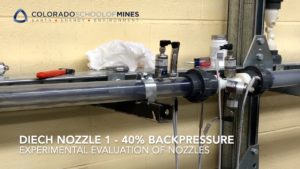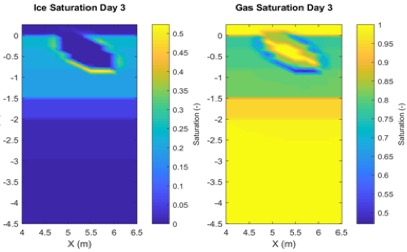Research
NOZZLE DESIGN AND EXPERIMENTAL EVALUATION TO MITIGATE LIQUID LOADING IN GAS WELLS
 An optimally designed nozzle can be used as an efficient artificial lift system to deliquify gas wells. Liquid loading is a major challenge that is faced during production from gas wells, where the accumulation of liquids at the bottom of the well occurs when the dominant gas phase is not able to lift all produced liquids to the surface. In this project we study the effect of geometrical parameters in the performance on venturi nozzles, under single and two-phase flow conditions. The main objective is to determine the most optimum nozzle parameters and geometry that maximize critical pressure ratio while minimizing pressure drop across the nozzle. Two separate facilities were used to conduct the two-phase (air and water) experiments: a horizontal facility with 1.5 in. inner diameter (ID) PVC pipelines and a 30 ft. long lateral pipeline section, and a vertical facility with 1.5 in. ID PVC pipelines and a 30 ft. long vertical pipeline section. The horizontal facility was used to study the effect of introducing water into the system as a second phase, and the vertical facility was used to simulate conditions of a gas well with a nozzle installed as an artificial lift system.
An optimally designed nozzle can be used as an efficient artificial lift system to deliquify gas wells. Liquid loading is a major challenge that is faced during production from gas wells, where the accumulation of liquids at the bottom of the well occurs when the dominant gas phase is not able to lift all produced liquids to the surface. In this project we study the effect of geometrical parameters in the performance on venturi nozzles, under single and two-phase flow conditions. The main objective is to determine the most optimum nozzle parameters and geometry that maximize critical pressure ratio while minimizing pressure drop across the nozzle. Two separate facilities were used to conduct the two-phase (air and water) experiments: a horizontal facility with 1.5 in. inner diameter (ID) PVC pipelines and a 30 ft. long lateral pipeline section, and a vertical facility with 1.5 in. ID PVC pipelines and a 30 ft. long vertical pipeline section. The horizontal facility was used to study the effect of introducing water into the system as a second phase, and the vertical facility was used to simulate conditions of a gas well with a nozzle installed as an artificial lift system.
- Students involved: Jagmit Singh (MS), Daniel Croce (PhD).
EVALUATION OF WATER ICE EXTRACTION FROM LUNAR PERMANENTLY SHADOWED CRATERS BY DIRECT HEATING
 Several observations from NASA studies have established that the permanently shadowed craters (PSCs) of the moon contain water ice and other volatiles. Water ice and other volatiles found in and near PSCs boost the idea that these resources can form the basis for a cis-lunar transportation economy. Methods for extracting water ice from PSCs fall into two categories: 1) methods heavily focused on excavation and 2) methods focused on delivering heat directly to the icy regolith. Methods focused on direct application of heat have received less attention, due in part to the lack of understanding of how volatiles flow through an icy regolith surface, how to design an efficient collector in such a system, and how to achieve an economically viable production rate. If these challenges are overcomed, methods focused on direct application of heat could require less mass removal and power compared to excavation methods as the inert component of the icy regolith remains in place. In this work, we develop a numerical reservoir simulator to model heat transfer from a wellbore into icy regolith, sublimation of ice and flow of water vapor through porous regolith. This will allow studying different well configurations to extract water ice from lunar craters, and assess feasibility by identifying limitations and challenges of such approach for lunar in-situ resource extraction.
Several observations from NASA studies have established that the permanently shadowed craters (PSCs) of the moon contain water ice and other volatiles. Water ice and other volatiles found in and near PSCs boost the idea that these resources can form the basis for a cis-lunar transportation economy. Methods for extracting water ice from PSCs fall into two categories: 1) methods heavily focused on excavation and 2) methods focused on delivering heat directly to the icy regolith. Methods focused on direct application of heat have received less attention, due in part to the lack of understanding of how volatiles flow through an icy regolith surface, how to design an efficient collector in such a system, and how to achieve an economically viable production rate. If these challenges are overcomed, methods focused on direct application of heat could require less mass removal and power compared to excavation methods as the inert component of the icy regolith remains in place. In this work, we develop a numerical reservoir simulator to model heat transfer from a wellbore into icy regolith, sublimation of ice and flow of water vapor through porous regolith. This will allow studying different well configurations to extract water ice from lunar craters, and assess feasibility by identifying limitations and challenges of such approach for lunar in-situ resource extraction.
- Students involved: Daniela Machnik, Emilio Gonzalez.
EFFECTS OF POLYMER INJECTION ON GEOMECHANICAL PROPERTIES OF RESERVOIRS
 Polymer injection (or polymer flooding) is an enhanced oil recovery method that relies on the mobility control of the injected aqueous phase, by increasing its viscosity. The lower mobility of the polymer solution within the porous rock improves the mobility ratio with respect to the displaced oil phase, and results in an increase of the volumetric sweep efficiency that maximizes oil recovery. Polymer solutions, used for enhanced oil recovery strategies, are high viscous non-Newtonian fluids that exhibit a pseudoplastic behavior (i.e., its viscosity decreases with increase in shear rate). The recovery of viscosity (at low shear rates) within the reservoir during an injection process, translates in a dynamic decrease of the injected fluid mobility. The changes in mobility could affect the pore pressure distribution within the reservoir. The distribution of reservoir pressure can be estimated using numerical reservoir simulation. In this project we use a commercial reservoir simulator to model a polymer injection process for enhanced oil recovery, and estimate changes in the stress distribution within the reservoir. We attempt to assess if the magnitude of stress changes could trigger any potential rock failure, based on heterogeneous distributions of rock mechanical properties.
Polymer injection (or polymer flooding) is an enhanced oil recovery method that relies on the mobility control of the injected aqueous phase, by increasing its viscosity. The lower mobility of the polymer solution within the porous rock improves the mobility ratio with respect to the displaced oil phase, and results in an increase of the volumetric sweep efficiency that maximizes oil recovery. Polymer solutions, used for enhanced oil recovery strategies, are high viscous non-Newtonian fluids that exhibit a pseudoplastic behavior (i.e., its viscosity decreases with increase in shear rate). The recovery of viscosity (at low shear rates) within the reservoir during an injection process, translates in a dynamic decrease of the injected fluid mobility. The changes in mobility could affect the pore pressure distribution within the reservoir. The distribution of reservoir pressure can be estimated using numerical reservoir simulation. In this project we use a commercial reservoir simulator to model a polymer injection process for enhanced oil recovery, and estimate changes in the stress distribution within the reservoir. We attempt to assess if the magnitude of stress changes could trigger any potential rock failure, based on heterogeneous distributions of rock mechanical properties.
- Students involved: Alberto Ramirez (MS), Arun Arunachalam.
EVALUATION OF COMPRESSED GAS STORAGE IN DEPLETED HORIZONTAL WELLS
 Power generation from renewable energy processes, such as photovoltaic cells and wind turbines, is intermittent in nature. In order to store the energy generated during this intermittent cycles, gas can be compressed using this energy. At the time that energy demand grows, the compressed gas could be expanded through a turbine to generate electricity. One of the main limitations with the storage of energy in the form of compressed gas is the large volume required for the gas storage. Depleted oil/gas horizontal wells with multiple hydraulic fractures, located in low-permeability (i.e., micro-Darcy to nano-Darcy) tight or shale formations, could represent an alternative destination for the compressed gas to be stored. In this project we evaluate the potential of horizontal wells with multiple hydraulic fractures for the storage of compressed gas using numerical reservoir simulation. A reservoir model is being developed using public information of horizontal well trajectories and completion designs from the Niobrara formation of the Wattenberg field, Colorado.
Power generation from renewable energy processes, such as photovoltaic cells and wind turbines, is intermittent in nature. In order to store the energy generated during this intermittent cycles, gas can be compressed using this energy. At the time that energy demand grows, the compressed gas could be expanded through a turbine to generate electricity. One of the main limitations with the storage of energy in the form of compressed gas is the large volume required for the gas storage. Depleted oil/gas horizontal wells with multiple hydraulic fractures, located in low-permeability (i.e., micro-Darcy to nano-Darcy) tight or shale formations, could represent an alternative destination for the compressed gas to be stored. In this project we evaluate the potential of horizontal wells with multiple hydraulic fractures for the storage of compressed gas using numerical reservoir simulation. A reservoir model is being developed using public information of horizontal well trajectories and completion designs from the Niobrara formation of the Wattenberg field, Colorado.
- Students involved: Muhammad Syamil Muhammad Adib.
SEDIMENTARY GEOTHERMAL FEASIBILITY STUDY
 In this project, we analyze the feasibility of commercial geothermal energy extraction from a sedimentary reservoir with low permeability. Using numerical reservoir modeling, we study the thermal evolution and lifetime of the reservoir with different enhancement techniques, such as hydraulic fracturing and/or long-reach horizontal wells. The Lyons formation in the Wattenberg field, Denver-Julesburg Basin, was chosen as the candidate geothermal reservoir for this study. A static reservoir model was developed, with analysis of available formation data, such as well logs, bottomhole temperature, porosity and permeability from core samples.
In this project, we analyze the feasibility of commercial geothermal energy extraction from a sedimentary reservoir with low permeability. Using numerical reservoir modeling, we study the thermal evolution and lifetime of the reservoir with different enhancement techniques, such as hydraulic fracturing and/or long-reach horizontal wells. The Lyons formation in the Wattenberg field, Denver-Julesburg Basin, was chosen as the candidate geothermal reservoir for this study. A static reservoir model was developed, with analysis of available formation data, such as well logs, bottomhole temperature, porosity and permeability from core samples.
This work was supported by the U.S. Department of Energy, Office of Energy Efficiency and Renewable Energy (EERE), Geothermal Technologies Office (GTO) under Contract No.DE-AC36-08-GO28308 with the National Renewable Energy Laboratory.
- Students involved: JaeKyoung Cho (MS), Mengnan Zhou (MS).